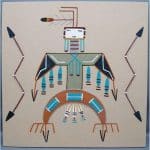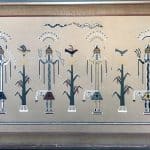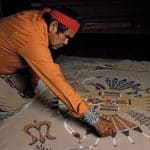The Art of Native American Sand Painting
by Jessica Kosinski
Among the many traditions of the American Southwest are Native American traditions steeped in cultural significance. One of those traditions is the creation of sand paintings. Sand paintings are beautiful and highly collectible works of art today. However, the original purpose of sand painting among the Native Americans of the American Southwest was to create a spiritual link to the gods. Therefore, before you collect them, it is important to understand what they represent. Let’s take a peek at the history of sand painting practices and why Southwest sand paintings are considered sacred.
Sand Painting Techniques
Sand painting is also sometimes known as dry painting. It is the art of sprinkling colored sand to create images. Sometimes other granulated substances, such as crystals or minerals, are also used to create sand paintings. Sand paintings can be fixed or unfixed. Unfixed sand paintings are temporary and usually produced for ceremonial purposes. Fixed sand paintings are typically made specifically to be sold as artwork.
Variations of sand painting have been practiced around the world in multiple cultures. For example, in Japan sand painting can be traced to the 15th century. At that time, Buddhists in Japan practiced the art of bonseki. Bonseki involved sprinkling sand on trays and brushing it with the feathers of birds to create elaborate images, typically of outdoor scenes, often using rocks to stand in as larger elements in the piece. Those creations were used as ceremonial tools. Tibetan Buddhists also practiced a similar form of sand painting, but those paintings were created on larger tables. The paintings served as mandalas, or symbols representing spiritual concepts.
Sand paintings and variations of sand art have also been created in many other cultures historically, as well as currently. For example, sand paintings feature prominently today in Mexican Day of the Dead celebrations. Sand bottles are also frequently sold as colorful souvenirs in various parts of the world. Although, some of them also have great value and historical significance. For example, Andrew Clemens was a famous U.S. sand bottle artist who practiced his art from the 1860s to the 1890s. Today, his works sell for thousands of dollars, and some of them can be found displayed in museums.
Sand Painting in the American Southwest
Traditional sand paintings in the American Southwest were made by Native American tribes. Most of them were created in unfixed forms for use in ceremonies relating to healing the sick. They were designed by skilled healers. Among the tribes that used sand painting for ritualistic purposes were the Zuni and Hopi. However, the sand paintings of the Navajo have become the most well-known and prized sand paintings of the Southwest.
In the Navajo culture, sand paintings are known as “places where the gods come and go.” They are ceremonial creations that can be viewed almost as spiritual portals. They are most often used in healing ceremonies. Although, they have also long been used in ceremonies relating to harvest times as well. Up to 30 or 40 of them can be used per ceremony. They are used in combination with other ceremonial Navajo rituals, such as chanting.
In healing ceremonies the sand paintings are typically made on buckskin or cloth; then they are blessed. After the sanctification process, patients sit on them and more ceremonial rituals take place. When the ceremony is over, the sand paintings are removed from the dwelling and the sand is poured back onto the ground in a nearby area to be disbursed by the elements and returned to its natural state.
Each element of a traditional Navajo sand painting had a specific design and a particular meaning. Accuracy was extremely important for each ritual and ceremony. Therefore, the Navajo healers who created them had to be highly skilled in their craft. Traditional Navajo sand paintings ranged in size from one foot in diameter to twenty feet. Many of them featured key elements, such as colors representing the Four Sacred Mountains. Those were the mountains surrounding the original Navajo territory.
The tradition of creating Navajo sand paintings was so sacred that the ceremonies were rarely allowed to be witnessed by outsiders. Also, the paintings could not be created specifically for sale as artwork. Since the ceremonial sand paintings were destroyed, the tradition of Navajo sand paintings being sold as works of art almost never existed.
That all changed in the mid-1900s. At that time, a Navajo named Grey Squirrel (Fred Stevens Jr.) developed a technique for creating fixed Navajo sand paintings that could be trans-ported. In so doing, he also created a marketable form of art that could help the Navajo people earn money. Since that time, selling sand paintings to tourists has been a lucrative practice among the Navajo people. They can easily be purchased throughout the Southwest, and are often found online.
None of the sand paintings created as art are ever used in traditional ceremonies. In fact, many Navajo sand paintings made since the 1960s have included imagery that is completely unrelated to Navajo healing ceremonies. Even those that are loosely based on ceremonial images are deliberately designed to be inaccurate to protect the sanctity of those ceremonies. Nevertheless, they are beautiful works of art that provide glimpses of traditional Navajo beliefs and practices.
Jessica Kosinski has been a freelance writer specializing in writing short articles for 15 years. She is also an avid collector of both antique books and Star Wars memorabilia. Although she is not in the antiques industry professionally, she has learned a lot about antiques over the years by periodically helping out at her mom’s antiques shop in Greenville, NH. She currently balances maintaining the antiques shop’s Facebook page, www.facebook.com/MallofNE, and working on various freelance writing assignments. She can be reached at dementorskiss77@yahoo.com.











Related posts: